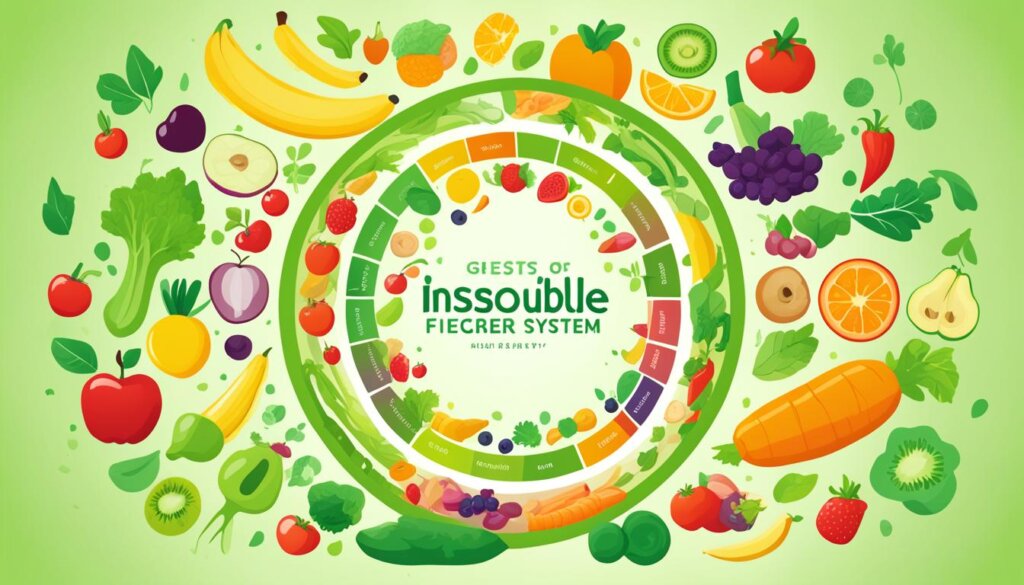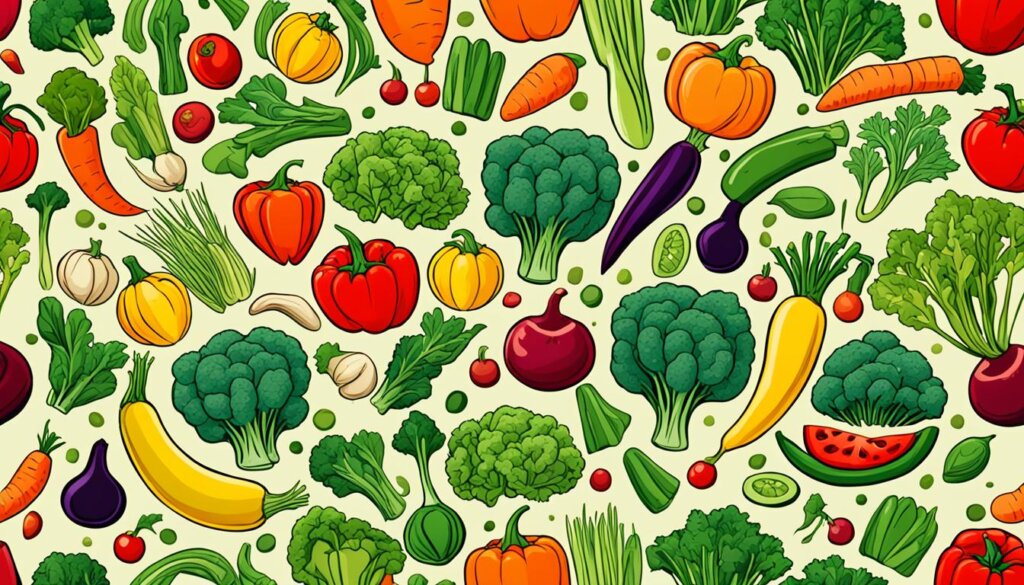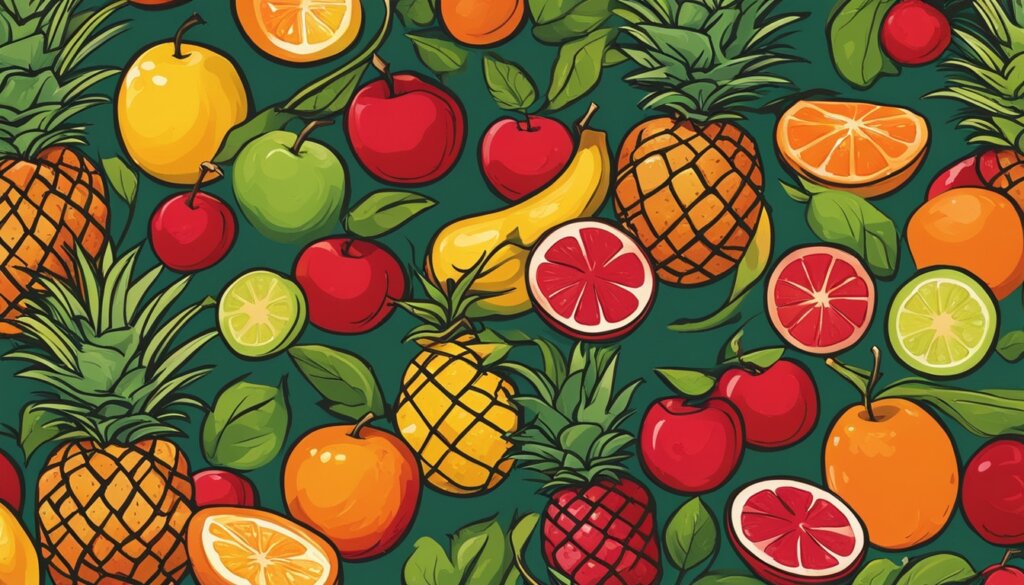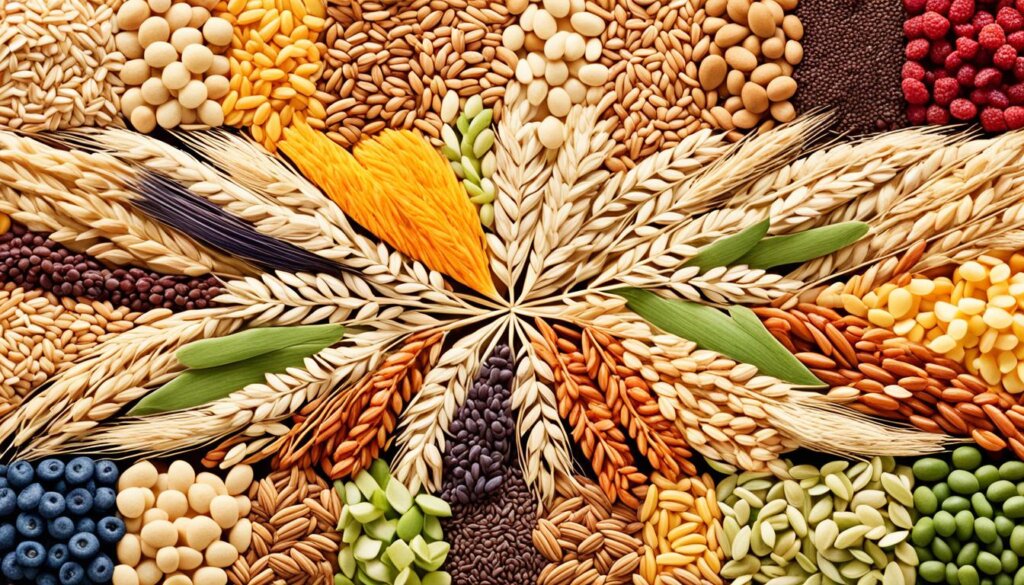FTC disclaimer: This post may contains affiliate links and we will be compensated if you click on a link and make a purchase.
Did you know the average American only eats 10-15g of fiber each day? This is much less than the advised 25g for women and 38g for men. Insoluble fiber is a key part of a healthy diet. It doesn’t dissolve in water and moves through your system mostly unchanged. It helps with keeping bowel movements regular, prevents constipation, and may lower your chance of getting diverticulosis or hemorrhoids.
Adding high-insoluble fiber foods to your meals is a great way to help your gut work better. You can choose from a wide range of foods like whole grains, veggies, nuts, seeds, and legumes. These foods are not only good for you but also tasty. In the next part, we’ll look at the best insoluble fiber sources to keep your digestion in top shape.
Key Takeaways
- Insoluble fiber is essential for digestive health, promoting regular bowel movements and reducing the risk of certain conditions.
- The average American falls short of the recommended daily fiber intake, consuming only 10-15g instead of the suggested 25-38g.
- Whole grains, vegetables, fruits, nuts, seeds, and legumes are all excellent sources of insoluble fiber.
- Incorporating a variety of high-fiber foods can help you meet your daily fiber needs and support overall gut health.
- Fiber intake is a good indicator of dietary quality, so tracking your fiber intake can help you maintain a balanced, nutrient-rich diet.
What is Insoluble Fiber?
Dietary fiber is key for a healthy diet, and it comes in two types: soluble and insoluble fiber. Insoluble fiber adds bulk to our stool, making it easier for our body to pass waste. Common types of insoluble fiber in our food are cellulose, hemicellulose, and lignins.
Explaining the Difference Between Soluble and Insoluble Fiber
Soluble fiber mixes with water to form a gel, while insoluble fiber does not dissolve. It helps move food through the gut, making stools bigger. Soluble fiber can lower bad cholesterol and blood sugar levels. Insoluble fiber keeps our gut healthy and is in things like veggies, fruits, and whole grains.
A review published in Food Science and Human Wellness showed how both fibers help our gut and might prevent diseases. But, the 2020-2025 Dietary Guidelines for Americans don’t say how much of each kind we need every day.
Over 90% of adults in the U.S. don’t get enough fiber, per the 2020-2025 Dietary Guidelines for Americans. The guidelines suggest how much fiber we should aim for each day, which depends on our age, sex, and if we’re pregnant. For example, men between 31 and 50 should get 31 grams a day, while women should aim for around 21 to 25 grams daily, and men for 30 to 38 grams.
Insoluble fiber, look to whole grains like wheat bran, brown rice, and couscous, or root vegetables such as carrots, parsnips, and potatoes. Fruits with seeds, beans, lentils, nuts, and vegetable skins also have a lot of insoluble fiber.
Getting enough insoluble fiber is crucial for gut health. It can help avoid constipation and lessen the chance of getting hemorrhoids or diverticulosis. Yet, those with diabetes should be careful with insoluble fiber to keep blood sugar stable. They should choose non-starchy veggies and fruits lower in carbs for their fiber needs.
In conclusion, knowing about soluble and insoluble fiber is important for a healthy diet. It helps keep our digestion in good shape, which is key for general well-being.
Benefits of Insoluble Fiber
Adding insoluble fiber to your eating habits helps your digestion a lot. It makes bowel movements regular and supports the health of your gut. Plus, it makes your stool bulkier, lowering your chance of getting hemorrhoids or diverticular disease.
Insoluble fiber does more than keep you regular. It can help control your blood sugar and lower bad cholesterol. There’s also a chance it could lower the risk of some cancers, such as colorectal cancer.
People need different amounts of fiber each day based on their age and sex. Sadly, most Americans don’t get enough. Adding more fiber-rich foods to your diet can be easy. It’s a great way to boost your overall gut and colon health.
“Fiber is the new superfood – it’s one of the most underappreciated and underconsumed nutrients, yet it offers a host of benefits for digestive and overall health.”
Insoluble fiber has a lot to offer. From making you go regularly to helping prevent serious illnesses, its benefits are clear. Just adding a bit more of these foods to what you eat can really improve your digestive and general health.

Top Insoluble Fiber Foods
Vegetables Rich in Insoluble Fiber
Vegetables are full of insoluble fiber, which doesn’t dissolve in water. It helps food move through the gut quickly. Broccoli, Brussels sprouts, and carrots are great sources. Sweet potatoes and turnips are too. Broccoli has 1.5 grams of insoluble fiber in every half cup. Meanwhile, half a cup of sweet potatoes has 1.8 grams. Eating these veggies can improve your digestive health because they’re full of fiber.
Cauliflower, green peas, spinach, and chard are also rich in insoluble fiber. Cooked cauliflower has nearly four grams of insoluble fiber in a cup. This amount grows when you cook raw cauliflower. A cup of green peas has over 15 grams of insoluble fiber. Cooked spinach and chard have between three to five grams per cup.

Eating a mix of these fiber-full veggies is good for your health. It ensures you get the fiber your body needs every day. This helps with digestion and keeps you regular. It can reduce the chances of digestive problems like constipation and diarrhea.
Insoluble Fiber Foods: Fruits
Many fruits are full of insoluble fiber just like vegetables. Apples, pears, avocados, and more are great sources. A medium apple has 1 gram of insoluble fiber. A pear of similar size has 1.5 grams. Avocados stand out with 2.1 grams of insoluble fiber in half a fruit.
Adding these fruits to your daily meals helps your digestive health. Women should get 28 grams of fiber a day, and men need 34 grams. Unfortunately, only a small percentage of people actually meet these goals. Including more fiber-rich fruits in snacks and meals can help you reach these targets. It leads to better digestion and more regular bowel movements.
Fruit | Insoluble Fiber Content |
|---|---|
Papaya | 2.5 grams per 1 cup of pieces |
Jackfruit | 2.5 grams per 1 cup when sliced |
Nectarines | 2.4 grams per 1 cup |
Pineapple | 2.3 grams per 1 cup of chunks |
Plums | 2.3 grams per 1 cup |
Raisins | 2 grams per 2 ounces |
Peaches | 2 grams per 1 cup |
Grapes | 1.5 grams per 1 cup |
Cantaloupe | 1.5 grams per 1 cup of pieces |
Watermelon | 0.5 grams per 1 cup when diced |
Some fruits, including avocados and bananas, also have soluble fiber. This type of fiber is good for managing cholesterol and blood sugar. Strawberries, blackberries, grapefruits, and oranges are low in sugar but high in fiber. They are great for keeping your diet balanced with fiber.

By eating a variety of fiber-rich fruits, you help your digestion and enjoy their flavors. Whether you like the creaminess of avocados or the crunch of apples and pears, there are many delicious ways to include insoluble fiber in your meals.
Whole Grains: Insoluble Fiber Foods
Whole grains are great for our gut because they have insoluble fiber. This type of fiber helps keep our digestion working well. Wheat bran, brown rice, barley, oatmeal, and quinoa are top sources of this fiber.
Take wheat bran, for example. It has 1 gram of soluble fiber in each half-cup serving. Cooked quinoa, on the other hand, has 2.5 grams of fiber in a half-cup. Most of it is insoluble. Eating whole-grain foods can up your fiber game, helping your gut feel better.
Grains High in Insoluble Fiber
- Wheat Bran: Has 13 grams of fiber in each half-cup. More than 90% is insoluble.
- Quinoa: Gives about 5 grams of fiber in every cup cooked. Around 78% is insoluble fiber.
- Brown Rice: Each cup cooked has about 3 grams of insoluble fiber.
- Oatmeal: A cup cooked gives you 4 grams of fiber.
- Barley: Is full of insoluble fiber. It’s a smart choice for your meals.
Add these power grains to your diet for more fiber and better gut health.

“Choosing whole-grain products over refined grains can significantly increase your intake of insoluble fiber and contribute to overall digestive health.”
Nuts, Beans, and Seeds: Insoluble Fiber Powerhouses
Nuts, beans, and seeds are super nutritious. They are high in insoluble fiber, which helps keep our gut healthy. For example, a one-ounce serving of almonds packs 3.5 grams of insoluble fiber. That makes them a great choice for a high-fiber snack. Flaxseeds are also rich in insoluble fiber with 2.1 grams in a two-tablespoon serving.
Lentils and black beans are especially good for your gut. They are full of insoluble fiber. A half-cup of lentils provides 3.8 grams, while a half-cup of black beans gives you 3.1 grams. Eating these foods helps your digestion and keeps you healthy.
- Almonds have 3.5 grams of insoluble fiber per 1-ounce serving.
- Flaxseeds give you 2.1 grams of insoluble fiber in a two-tablespoon serving.
- Lentils are rich with 3.8 grams of insoluble fiber in each half-cup.
- Black beans provide 3.1 grams of insoluble fiber in a half-cup.
Food | Insoluble Fiber (per serving) |
|---|---|
Lentils (1 cup boiled) | 18 g |
Split Peas (1 cup boiled) | 16 g |
Black Beans (1 cup canned, unsalted) | 15 g |
Pinto Beans (1 cup boiled) | 15 g |
Artichoke Hearts (1 cup cooked) | 14 g |
Kidney Beans (1 cup cooked) | 12 g |
Chickpeas (1 cup cooked) | 12 g |
Chia Seeds (2 tablespoons) | 10 g |
Nuts, beans, and seeds are top sources of insoluble fiber. Eating these helps keep your digestive system and body healthy. Including lots of high-fiber foods in your diet supports good gut health.
“Fiber is essential for digestive health. Nuts, beans, and seeds are easy ways to get more fiber.”
Insoluble Fiber Foods and Digestive Health
Insoluble fiber is key for a healthy gut. It adds bulk to stool, making bowel movements regular. This can prevent constipation and lessen the chance of getting diverticulosis or hemorrhoids. By eating foods rich in insoluble fiber, you keep your digestive system on track and avoid common issues.
Think of foods like whole-wheat, nuts, and veggies when you hear about insoluble fiber. These foods help your stool move better, avoiding constipation. Also, including plenty of fiber in your diet might protect you from gut and heart problems, as well as some types of cancer.
If you find it hard to eat enough fiber every day, consider supplements. Metamucil, Citrucel, and FiberCon are good options. They can help you reach the 25-38 grams of fiber you need each day.
Don’t forget, a mix of whole grains, fruits, and veggies is best for your gut. These foods are packed with insoluble fiber. They keep your digestive system healthy and lower the risk of issues. Adding these meals to your daily plan is a great step for good digestion.
Balancing Soluble and Insoluble Fiber Intake
It’s important to eat both soluble and insoluble fiber for a healthy gut. You should aim for 25-30 grams of fiber each day. But, most adults only get around half of that amount.
To improve your gut health, eat a variety of foods rich in fiber. This includes fruits, vegetables, nuts, and whole grains. It helps your digestive system work well.
The Importance of a Diverse Fiber-Rich Diet
Soluble fiber comes from foods like oats, beans, and some fruits. It can lower blood sugar and cholesterol, and keep you regular. Aim to get about 10 grams of soluble fiber a day as part of a healthy diet.
Insoluble fiber is found in foods like whole grains and vegetables. It adds bulk to your stool and keeps you regular. Remember to take in more insoluble fiber than soluble, about 20 grams daily.
A diet rich in fiber helps with weight loss and keeps you healthy. It’s important to get both types of fiber for a happy gut.
Eat a mix of fruits, vegetables, and whole grains for good gut health. These foods provide both types of fiber. This is important for your digestive system and your overall health.
Soluble fiber changes to good bacteria in your gut. This helps keep you healthy. Studies show that eating enough fiber lowers the risk of diseases.
More fiber means you might weigh less and be healthier. A certain kind of fiber called resistant starch is great for your gut’s good bacteria. It also helps relieve constipation.
How much fiber you eat affects your gut health a lot. It can make your gut stronger and affect the kind of bacteria in it.
Eating fiber is better than taking supplements. One review showed that adding fiber to the diet helps people with IBS. It works better than a placebo but only start if you can’t get enough from food.
Some foods help with constipation while others help stop diarrhea. Fiber supplements can cause some discomfort if you start too fast. But, getting fiber from real foods is the healthiest way.
Eating well with both types of fiber helps your digestive system. This leads to a happier gut and better health for you.
Conclusion
Adding insoluble fiber-rich foods to your meals keeps your digestive health strong. Foods like whole grains, veggies, fruits, nuts, beans, and seeds help in many ways. They help with regular bowel movements, fight constipation, and might lower the risk of some health issues like diverticulosis and hemorrhoids.
It’s good to eat both soluble and insoluble fiber for your gut health and overall well-being. Try to eat plenty of these high-fiber foods every day. It can make your stomach and body feel better.
Don’t forget, that you need 25-34 grams of fiber every day, depending on your age and sex. But, most people in the US only get about 17 grams. Easing more insoluble fiber foods into what you eat helps. It lets you hit the target and keeps you healthy.
FAQ
What is the difference between soluble and insoluble fiber?
Soluble fiber mixes with water, forming a gel. Insoluble fiber doesn’t mix with water. It helps push food through your guts.
What are the health benefits of insoluble fiber?
Insoluble fiber keeps your bathroom visits regular. It helps your gut stay healthy. This can lower the chance of getting problems like hemorrhoids.
It could also control your blood sugar and lower your cholesterol. Less cholesterol means a lower heart disease risk.
What are some good sources of insoluble fiber?
You can find insoluble fiber in quite a few foods. Whole grains and veggies are great, like wheat bran and broccoli. Nuts and fruits, such as apples and guavas, are good sources too.
Don’t forget about beans and seeds. They’re also packed with insoluble fiber.
How can insoluble fiber help with digestive health?
Insoluble fiber makes your poop bigger and softer. This makes going to the bathroom easier. It can prevent constipation and certain gut problems.
Eating enough insoluble fiber might also stop you from getting diverticulosis or hemorrhoids.
Why is it important to balance soluble and insoluble fiber intake?
Both types of fiber are good for you. Mixing them in your diet helps keep your gut healthy. Soluble fiber can check your blood sugar and cholesterol. Plus, it helps you go to the bathroom often.








